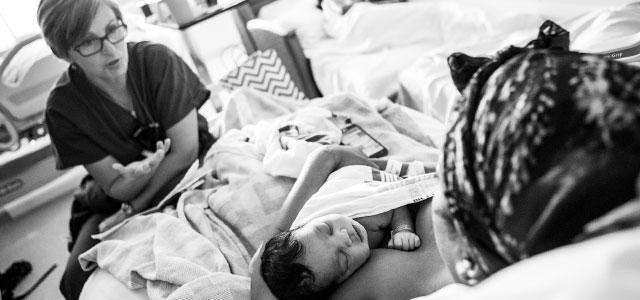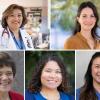
Nurse-midwife Laurie Jurkiewicz talks with a new mother (photos by Elisabeth Fall).
Laurie Jurkiewicz: A Passion for Midwifery and Women’s Health
Volunteer clinical faculty and preceptors offer students individual perspectives and hands-on experience in a variety of health care settings and specialties. The cumulative effect of what these volunteers impart plays a significant role in the care any health system delivers. This series aims to shed light on the unique roles these valuable mentors play.
This month, we hear from Laurie Jurkiewicz, a certified nurse-midwife at San Francisco General Hospital and assistant clinical professor in the Department of Obstetrics, Gynecology & Reproductive Sciences. The accompanying photo essay provides a glimpse into her busy professional life.
When I first went into nursing, I didn’t know much about midwifery. I received my BSN from the University of Michigan School of Nursing in 1989 and got a job at the University Hospital. Most of the patients had chronic diseases like Crohn’s or sickle-cell anemia. The pain and the medication they had to take to manage it adversely affected their lives, so I became interested in alternatives.
I heard about midwifery because there were midwives working at the University Hospital, and it piqued my interest because I was interested in women’s health and alternative medicine.
I moved to Colorado and got immersed in birth through my job at what was then Denver General Hospital (now Denver Health), a busy urban facility that did about 300 births per month. While there were no midwives working there, I met several through my work on labor and delivery. I realized that’s what I wanted to do, but there were a couple of detours along the way.
First, I joined the Peace Corps and taught nursing at a hospital-based program in a small village in Malawi for several years. Although it delayed my going to midwifery school, this was invaluable experience because I had to learn so many things that weren’t taught in nursing school. It also led, indirectly, to my getting a job in emergency nursing, because when I finished my assignment, I used my readjustment allowance to travel more, and when I returned to the US, I was broke and needed a job. The only one I could find was in a 120-bed emergency department in downtown Detroit. That was the toughest job I’ve ever had, due to the racial tension and violence in the community, but it helped me hone my skills, particularly working with my hands, which is important in midwifery.
In 1999, I got my master’s in nurse-midwifery from UC San Francisco School of Nursing and worked in a small private practice in the Central Valley. Three years later, I was recruited back to work and teach at San Francisco General Hospital (SFGH).
One of the best things about working in this setting is having the opportunity to work on a wide variety of things and develop different skills. In addition to working in the prenatal clinic and attending deliveries at SFGH, I’m involved in research into a dental intervention to teach people to do self-care and assessment; we’re measuring outcomes around preterm birth, which may be associated with periodontal disease. I also work in the Women’s Options Center, which is very important to me. As a midwife, I’m intensely interested in birth, but I also see what women go through to get an abortion. We do late-second-trimester abortions, which is necessary due to reduced access to abortion, particularly for uninsured or underinsured women.
One of my favorite activities is leading CenteringPregnancy groups at the San Francisco Homeless Prenatal Program. CenteringPregnancy is a group model of prenatal care, and I love it because it allows me to relate to my patients in a different way. As a facilitator, I go from providing one-on-one care, in a setting in which the provider has the most power and the culture is medical, to a setting where I’m only one of 12 other people, and the culture of the group is most important, so it’s more equal. It’s a powerful way to reach patients and help them make positive changes in their lives. I also work with the national Centering organization, consulting with other sites around the country to help them start Centering programs and train staff.
Recently, through Larissa Duncan and Nancy Bardacke at the Osher Center for Integrative Medicine, I’ve become involved with mindfulness practice. Mindfulness encourages staying in the present and being awake to experience, and it’s been profoundly helpful to me – so much so that I’ve enrolled in a program at the UCLA Mindful Awareness Research Center to become certified to teach it. I’ve incorporated it into my Centering Pregnancy groups, and it’s been very well received.
Teaching is an essential part of what I do; at SFGH, it’s rare for me not to have a student with me. In addition to midwifery students, I teach medical students who are interested in women’s health. The students bring a great deal of energy to their work, and they constantly challenge me. It can be difficult to deal with a student who’s having trouble learning what you’re trying to teach, but it’s also gratifying. Students are both very smart and very vulnerable, so communication is important, and we work very closely together, particularly in labor and delivery; the connection is almost like an umbilical cord. I remember being with a student for her first birth, and when we were down on the floor (the mother was in a birthing stool), the student looked at me with such fear – something I remember from my first days in labor and delivery. I smiled back at her and said, “This is actually really fun.” It was wonderful to see how comfortable she was at the end.
I enjoy the diversity of the patients at SFGH, the other faculty and the energy of the students, and teaching reinforces my passion for my work. Midwifery commands my whole self – my thinking self, my emotional self, the part of me that’s good with my hands – every part of me. This is what I was meant to do.



